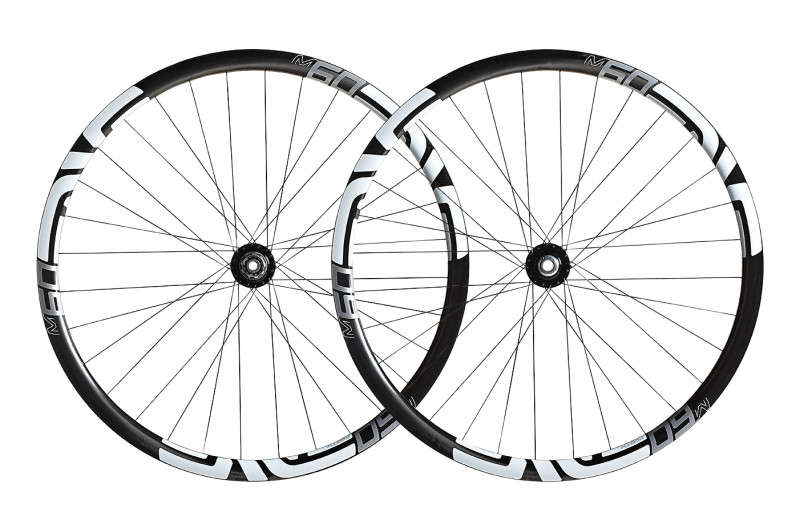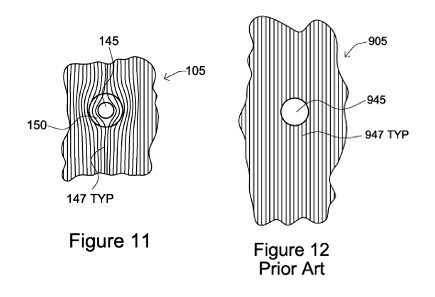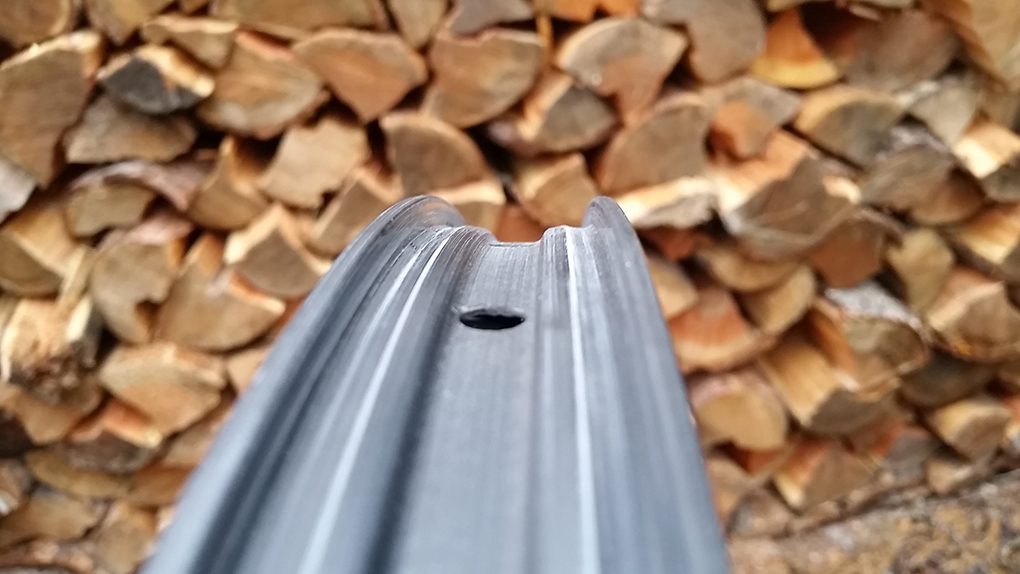
ENVE M60 Forty HV 29” Wheels
Built with:
- Chris King ISO Disc Hubs
- Sapim CX-Ray Spokes (32, 2 cross)
Internal Rim Width (measured): 26 mm
External Rim Width (measured): 31.5 mm
Blister’s Measured Weight:
- Front: 776 g
- Rear: 959 g
- Total: 1735 g
MSRP: $2748
Reviewer: 5’9” 155 lbs
Test Duration (Updated): 10 months of ride time / ~1000 miles
Test Locations: Whitefish, MT; Nelson, BC
[Editor’s Note: We’ve put a whole lot more time on these rims since we initially wrote about them, so this is now our updated, long-term review.]
Intro
As I sit down to write this review, I realize that I’ve made a terrible mistake. And an expensive one. Because I now want these wheels on every bike I own.
ENVE was one of the first companies to enter the carbon rim market on the mountain bike side of things, everything they make is made in the U.S., and they continue to be one of the most influential players when it comes to high-end wheelsets. If you’re interested in a bit more of the backstory, check out our industry profile of ENVE from a few years back.
The most recent news from ENVE is the introduction of the “HV” (High Volume) option for a number of their rims. In other words, ENVEs are getting wider.

The M60 line is situated in the middle of ENVE’s lineup, and is designed around mid-travel trail bikes. Technically, the wheel’s name is the M60 Forty HV, which means that it’s intended for sixty percent downhill, forty percent uphill, and they’re the High Volume (wide) version.
Now, before I go any further, a quick note: these things are expensive, so I’m going to be hyper-critical—issues that might get a pass on a $500 wheelset don’t get a pass when the price tag is premium.
Rim Width
If you haven’t taken a look at our overview of ENVE’s HV rims, check that out. The long and short of it is, ENVE has spent a good amount of time researching widths and finding the optimal combination of tire support + low weight. The M60 HV’s have an internal width of 26 mm, which is designed with 2.3” – 2.4” tires in mind.
We’re also putting time on the next size up, the ENVE M70 HV’s, so stay tuned for a comparison between those and the M60’s. My preliminary impression is that the M70 HV is a pretty burly wheel. It seem like it’s overkill for a trail bike, and it’s probably even overkill for a lot of “enduro” bikes. In other words, for many bikes that are going to be pedaled to the top of a descent, I’d lean toward the M60 HV’s.
Rim Construction
There are a few noteworthy aspects of ENVE’s products. First, many of their products, and all of their rims are made in the U.S., in Ogden, Utah. Particularly for carbon fiber products, that’s very much an exception in the bike industry.
Second, via a patented process, they mold the spoke holes in the rim rather than drill them. Less expensive carbon rims will mold the rim without holes, then drill them. The downside of drilling them is that the actual carbon fibers are being cut. Carbon derives a lot of its strength from those fibers remaining intact—this is why it’s bad if you crash and gouge your carbon bars; the gouge may have severed some of the fibers. So drilling holes through the fibers either means the rim isn’t as strong as it could be, or they have to make the carbon extra thick (and thus heavier) to make up for the lost strength.
Here’s a picture from ENVE’s patent for the hole molding process. Enve’s uninterrupted carbon fibers are shown on the left, while Figure 12 shows how drilled spoke holes affect the carbon’s fibers.

Another upside of molding the spoke holes into the rim is it allows for the shape of the material immediately surrounding the hole to be more accurately controlled. On a traditional aluminum rim, some rim manufacturers drill the holes at an angle to match the angle the spoke enters the rim (see, for example, WTB’s “4D” drilling). This helps the nipple sit flush against the rim, which makes for a more even-load distribution. Getting a properly angled surface for the nipple to sit flush against can be tougher with a carbon rim, but by molding the hole and the area immediately surrounding it, ENVE’s able to create a more uniform surface than if they were to drill the hole.
For largely the same reasons that they mold the spoke holes, ENVE’s rims don’t have a bead hook—the interior of the sidewall is flat. This makes the rim stronger (since there’s more material there), and as with the spoke holes, it means ENVE doesn’t have to sever any carbon fibers by machining in a hook. Hookless rims have been around for a little while, and the general consensus (which I fully agree with) is that it’s a non issue and the tire stays seated just fine.

ENVE also doesn’t leave any bladders in the rim. Most hollow carbon products are made by wrapping the carbon around something, then subjecting it to pressure and heat. In the case of rims, that internal form is usually a bladder; basically, a balloon.
The trick is: what to do with that bladder once you’ve got a rigid carbon structure wrapped around it? The easiest thing is to leave it in there, but that adds a bit of weight, and it’s messy. On some carbon frames, you can stick your fingers in the bottom bracket or headtube and feel the remnants of those bladders. But on ENVE rims, the bladder is entirely removed which makes for a lighter rim with a more even weight distribution.
From talking with various engineers, it’s clear that proper use of carbon has come a long way in the bike industry. There’s a delicate balance of weight, durability, and desirable ride characteristics that’s often elusive. This, in large part, is the reason that there are really expensive road bikes: achieving the perfect blend of compliance in one direction and stiffness in the other isn’t an easy task.
And this same conversation translates directly to carbon rims. Lateral stiffness is highly sought after, whereas some degree of vertical compliance sure is nice on long rides. And while this isn’t to say that ENVE has necessarily found the holy grail in this regard, it is worth noting that they’ve been refining their carbon rims for longer than most, and they’ve expended a lot of hours figuring out what the perfect blend of weight, durability, and compliance might be, and then even more hours figuring out how to construct little details like the aforementioned molded spoke holes.
NEXT: The Wheel Build, Mounting and Setup, Etc.

………carbon rims are still relatively new to the mountain bike world, and they need to be fully vetted.
Yes, critically vetted. If the rims are wear parts on your bike, if you ride most of the time with good speed in rocky terrain with loose stones, than I can tell you my experience.
After 9 Months of usage, the front wheel of my Carbon Sram Roam 60 29 – with a Michelin WildrockR2 mounted – cracked suddenly in a rock garden (25mph speed). I crashed (high side) hard and had a lot of luck to survive (crashed into stone blocks)…cash replacement on carbon wheels are nice (SRAM did not offer this), but nobody wants to be a crash test dummy.
The problem is, carbon rims breaks without any previous signs…..hear some photos of my cracked SRAM Carbon front rim.
http://fotos.mtb-news.de/p/1969399
http://fotos.mtb-news.de/p/1969395
Mountain bike wheels with internal nipples are just silly. I have a set of these wheels and have had numerous spoke failures. Spoke failures will happen on MTB wheels and on these wheels, the effort to remove the tire and then reseal to change a spoke offsets any of the other virtues these wheels provide. The tires are often very difficult to remove on the trail. This can be improved by substituting Stans or Schwalbe rim tape for the significantly thicker Gorilla tape.
Nice review. As far as internal nipples on an mtb wheel, I’m firmly in the “never” camp. Ditto CK hubs. Arguably the best in the biz, but after 15 years, I just got tired of the finicky preload adjustment (esp in back) and somewhat sadly went to DT hubs. So easy.
I’ve had good luck with Derby/DT 350 wheels, and GREAT luck with Nox Teocali/DT 350 wheels. Nox hired some hot shit wheelbuilders and it shows on my truing stand and tensiometer after about 30 hours.
Unrelated request: As a subscriber, I’d like to put in a request for a 1X chainguide comparison. There are some intriguing and light ones out there (MRP, One-UP, e13 come to mind).
Thanks!
Hey Tom,
Good insight on the hubs. I’m actually spending time on some M70’s at the moment that are laced to DT 240’s. Those things are definitely bomber, but I do occasionally find myself annoyed with the slow engagement (which I could upgrade, but I feel like a high end hub shouldn’t need to be upgraded).
We don’t have any reviews of chainguides in the pipeline at the moment, but we’ll try to put something together on that front. Stay tuned.
I’d stay away from carbon wheels. Have few friends who cracked the rims on brand name expensive wheelsets and went back to aluminium.
There’s simply no reason to go for carbon rim for when riding full suspension bike and a voluminous tires. The theoretical difference in stiffness is masked by tires and suspension.
You can get excellent aluminium wheelset for the same weight and fraction of the price of these enves and it will last longer.
Think of DT 240s with EX471 or XM481 rims.
Carbon is really not the material you want to expose to loose rock strikes.
Great review. I appreciate you always trying to find ways of explaining the more technical aspects of your reviews to the less knowledgeable or less patient.
This review reminds me that what I really wish Blister would capitalize on, is long term reviews. The German Site Enduro MTB routinely does a Long Term Review a year or two after doing an initial review. For something like a carbon wheelset, I feel like this would be especially valuable.
Thanks
Hey Michael,
Thanks for the note! We’ll definitely be following up with a longer term review on these Enves, as well as some other wheelsets we’ve reviewed lately. Because like you said – for something like a carbon wheelset, it’s the long term durability that really matters.
I am curious about all of the comments here about the lack of durability of carbon rims. Has anyone in the industry actually spent the time to prove or refute the perceived lack of strength and durability of carbon VS alloy? Has that comparison also factored in a sliding scale of price point in the category VS those in the other? You can buy knock off Asian carbon rims and knock off Asia or Euro alloy rims, and from what I have seen first hand they will not be as good as the real thing. Is knock off or b tier carbon more affordable? Hell yes. Would you be better off buying a high end alloy rim than a cheap carbon rim? I would say yes. Something tells me there is more this conversation than just a carbon VS alloy argument. For what it’s worth, I have now owned 5 sets of ENVE wheels – both road and MTB – and they have been the truest, most durable and best ridging wheels I have ever owned. After over 35 years riding high end bikes, I will state without hesitation that they are the single most trusted and durable bike related items I have ridden. Remember, wheels are the soul of any bike. If you are going to spend money on something to really move the needle on the performance of your bike, then spend it on wheels, then spend it on suspension tuning/components and take the time and money to keep these parts working correctly. After that, if your bike fits you, good choices were made about your terrain VS travel, your riding style and wheel size, then you are probably set for your best ride.